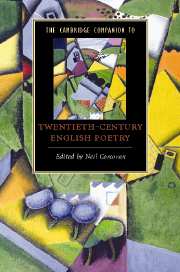Book contents
- Frontmatter
- Introduction
- Part I Contexts
- Part II Moderns
- Part III Modernists
- Part IV Later Modernities
- 10 Philip Larkin: a late modern poet
- 11 R. S. Thomas and modern Welsh poetry
- 12 Gender, feminism, poetry: Stevie Smith, Sylvia Plath, Jo Shapcott
- 13 Varieties of poetic sequence: Ted Hughes and Geoffrey Hill
- 14 Black British poetry and the translocal
- 15 Poetry and class: Tony Harrison, Peter Reading, Ken Smith, Sean O’Brien
- 16 A Scottish Renaissance: Edwin Morgan, Douglas Dunn, Liz Lochhead, Robert Crawford, Don Paterson, Kathleen Jamie
- 17 Lyric adaptations: James Fenton, Craig Raine, Christopher Reid, Simon Armitage, Carol Ann Duffy
- Index
13 - Varieties of poetic sequence: Ted Hughes and Geoffrey Hill
from Part IV - Later Modernities
Published online by Cambridge University Press: 28 January 2008
- Frontmatter
- Introduction
- Part I Contexts
- Part II Moderns
- Part III Modernists
- Part IV Later Modernities
- 10 Philip Larkin: a late modern poet
- 11 R. S. Thomas and modern Welsh poetry
- 12 Gender, feminism, poetry: Stevie Smith, Sylvia Plath, Jo Shapcott
- 13 Varieties of poetic sequence: Ted Hughes and Geoffrey Hill
- 14 Black British poetry and the translocal
- 15 Poetry and class: Tony Harrison, Peter Reading, Ken Smith, Sean O’Brien
- 16 A Scottish Renaissance: Edwin Morgan, Douglas Dunn, Liz Lochhead, Robert Crawford, Don Paterson, Kathleen Jamie
- 17 Lyric adaptations: James Fenton, Craig Raine, Christopher Reid, Simon Armitage, Carol Ann Duffy
- Index
Summary
The poetic sequence
Chances are that the word 'sequence' when used of English poetry will first conjure the Elizabethan sonnet sequence, beginning with Sidney's Astrophel and Stella (1582), and including Spenser's Amoretti (1595) and Shakespeare's Sonnets (1609). Not all the sequences of the Golden Age are wholly devoted to the sonnet - Sidney's has ten songs in addition to 108 sonnets, and Spenser concludes his eighty-eight sonnets with 'Epithalamion' - but the sonnet is certainly the dominant form. Each sequence is held together by a complex theme, love, and a loose drama or narrative development: unhappiness in an erotic relationship or, with Spenser, eventual marital bliss. Variation in theme notably occurs with Donne's 'Holy Sonnets' (1610-11), while George Herbert's The Temple (1633) presents a booklength sequence of religious lyrics only some of which are sonnets, and which is structured as much by reference to church architecture as by a narrative of spiritual development. The lyrical sequence detached itself from the sonnet sequence at an early stage, although it took several centuries to find its characteristic level as a medium-length-to-long poem that links together lyrics in a variety of stanzaic patterns.
Adjustments to the sonnet form by George Meredith in Modern Love (1862) opened the way for further (mostly deferred) experiments in the sonnet sequence, not all of which were successful. A century after Meredith, Robert Lowell wrote several volumes of fourteen-liners without rhyme or metre, of which very few individual poems have proved memorable.
- Type
- Chapter
- Information
- The Cambridge Companion to Twentieth-Century English Poetry , pp. 187 - 199Publisher: Cambridge University PressPrint publication year: 2007
- 1
- Cited by

